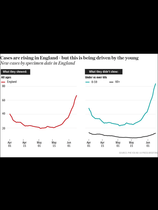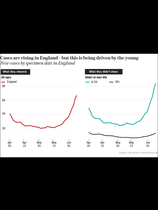I expect to be trampled underfoot by those more experienced than I in the matter of statistics ( Remember, “There are lies, damned lies and statistics”)
However what bothers me is when graphs of % appear to show doom and gloom, while raw numbers say otherwise - or vice versa.
I live in a village of 1000 inhabitants so it would take 100 positive diagnoses to say our Covid rate was 1 in 100,000. Yes?
That figure is unimaginable. Or have I got this arse about tip?
I think we may have had a total of about 20 cases over the course of the pandemic and no fatalities, but if the four cases last month had followed on from two the month before would the local headlines (if we had any) have screamed 100% rise in cases - ?
So looking at the Downing Street press conferences, I and others fear Boris Johnson’s scientific advisers seem to be deploying their graphs skilfully and selectively to back up the warnings of potential catastrophe.
But take a closer look and the choice of graphs is arguably disingenuous: the slides are most revealing for what they failed to include.
On hospital admissions, we were shown a graph comparing the change in the proportion of under and over-65s admitted to hospital in January and in May-June.
This showed a big jump in the under-65s column, a point Prof Chris Whitty, England’s Chief Medical Officer, took pains to emphasise.
The problem is that this fails to show just how much lower the raw , actual numbers are now.
In reality, there were 95,172 admissions for Covid in England between Jan 1 and 28, compared with 2,851 between May 16 and June 12.
But a brief glance at the graph – which is all you get on TV before “Next slide please” could well give the impression that the situation in hospitals is worse than last winter.
These are from today’s DT and I suppose I, like many am feeling depressed that despite being better vaccinated than just about any country in Europe, we are more locked down than they are too.
Brussels police ordered to attend a right wing conference attended by Braverman and Farage






